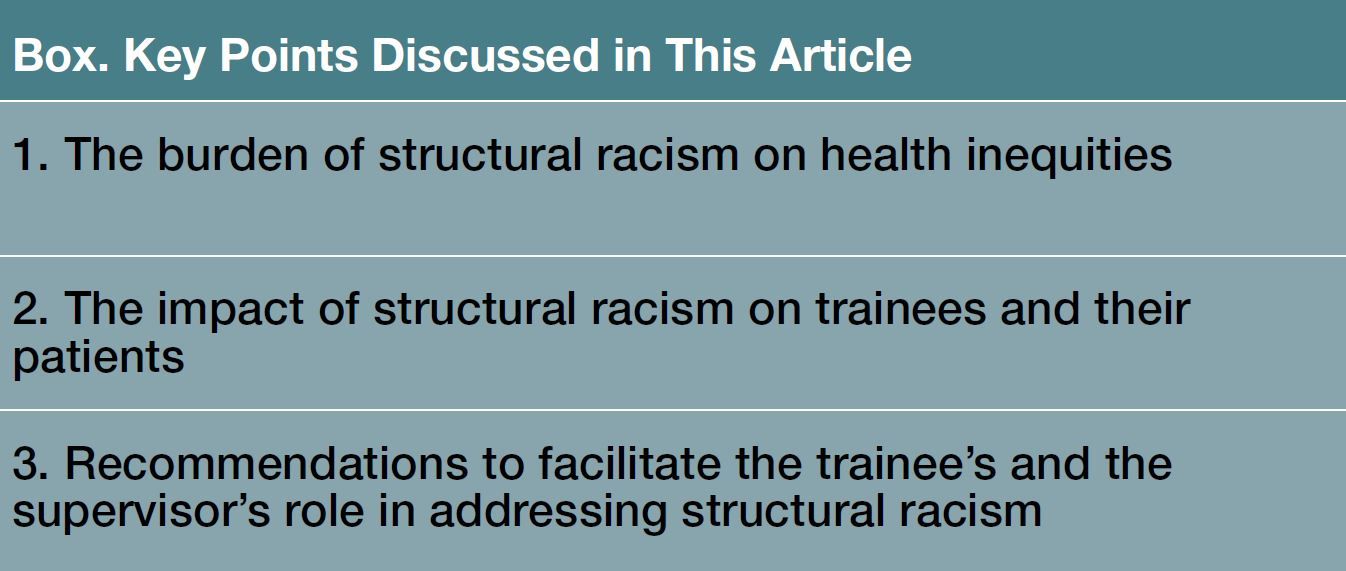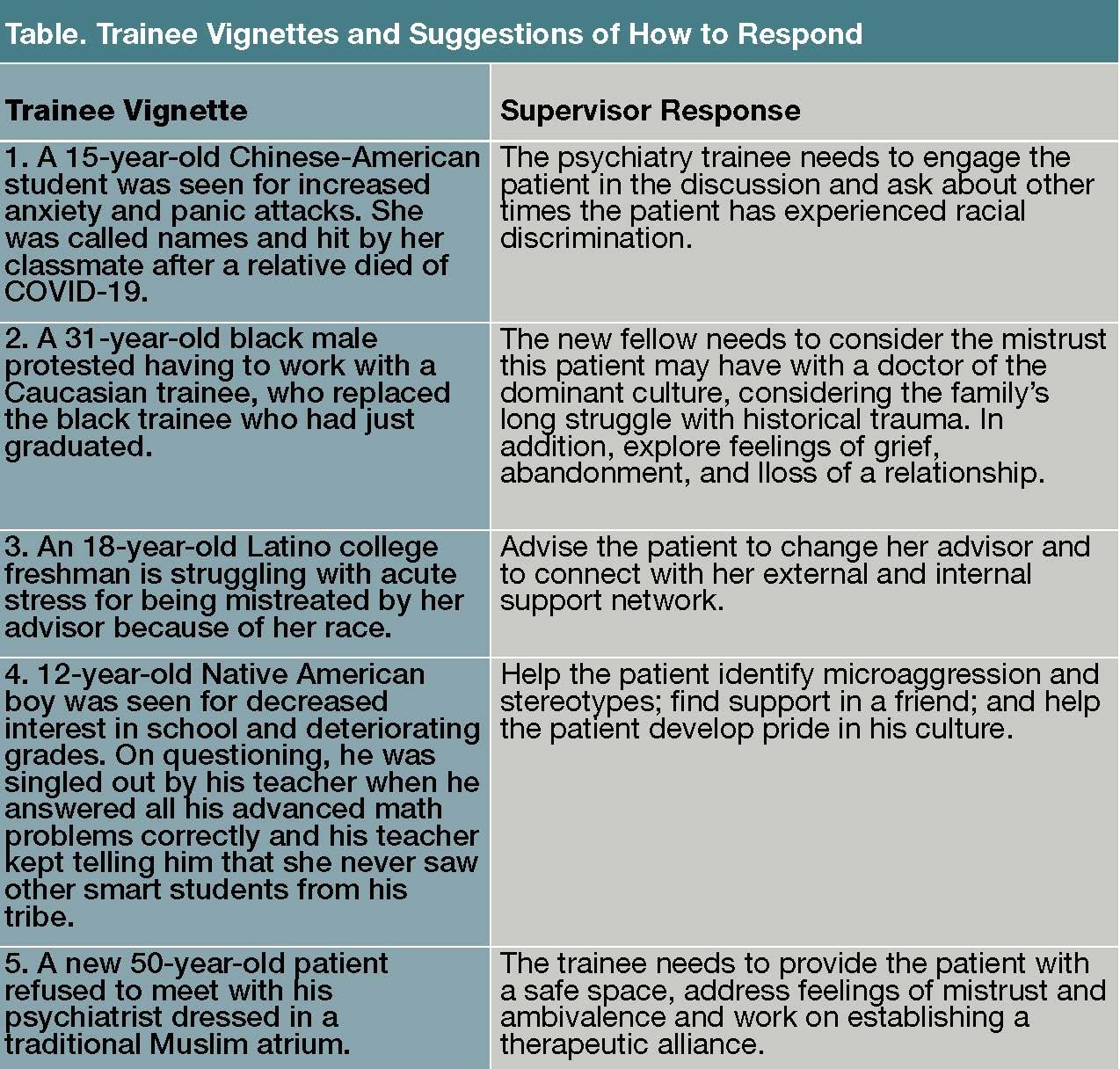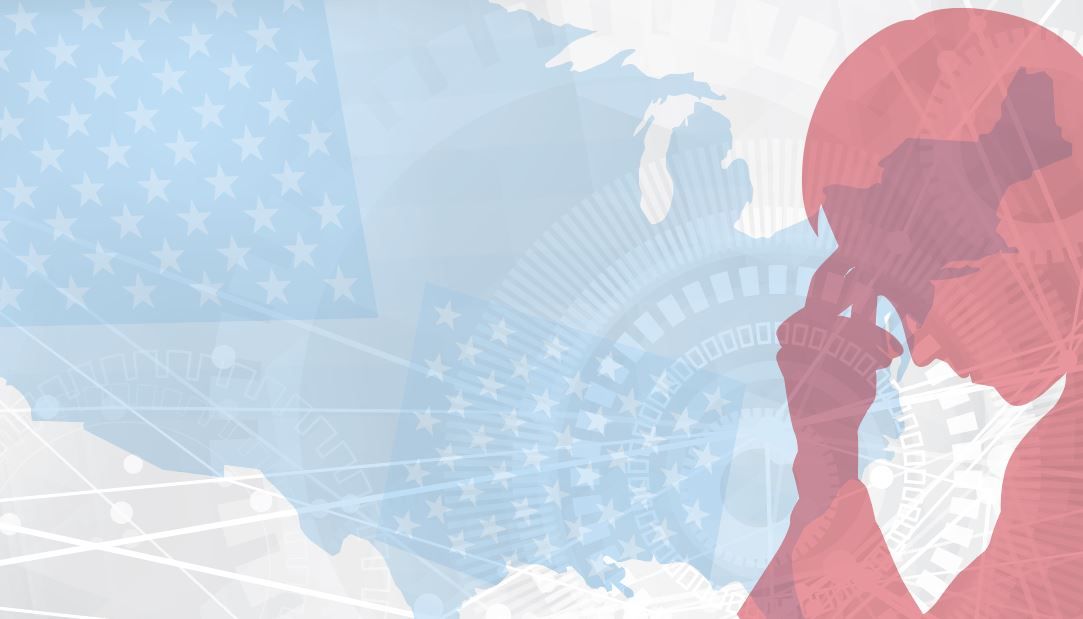BLACK HISTORY MONTH
-Series Editor, Frank A. Clark, MD
Psychiatry trainees work in a challenging world. Some have firsthand experience with bias, microaggressions, and racism, including in their training.1 For example, there are enormous challenges faced by Black trainees, with only 5% of American physicians identifying as Black.2 Underrepresented minority physicians have reported being questioned about their identity and are subject to discrimination, marginalization, and frank racism when patients or families refuse treatment by a minority physician.3 They often must accommodate racist comments without addressing them, ignoring their own emotional pain, focusing instead on placating patients and families and successfully completing their training. They work in a system in which the majority of department chairs, hospital CEOs, and medical school administrators are white.4
Trainees may question the lag in recruitment of faculty and trainees of color by leaders of medical schools or academic institutions. They wonder about opportunities for mentorship offered by their educational institution to alike trainees or efforts to retain diverse faculty.5 The coronavirus disease 2019 (COVID-19) pandemic has exposed cracks in the system at a time when these leaders are being asked to focus on issues of race and health disparities.
When psychiatrists begin their training, they experience a myriad of unknowns, including internal conflicts about their abilities, the need to master their anxiety, and the push-pull of ensuring they pay due diligence to the issues facing their patients. As they negotiate the interpersonal issues related to dealing with the multidisciplinary team, their peers, as well as patients, they look to their supervisors and the training institution for guidance and support. They attend mandatory didactics and conduct literature searches for edification. In the absence of scientific literature and sparsity of information provided during didactics to address racism experienced by patients and trainees alike, supervision becomes the most important tool to address the trainees’ concerns.
More from the Black History Month collection
Series editor, Frank Clark, MD: Mentorship: Salute to a Windy City Educator
Balkozar Adam, MD, Rameshwari V. Tumuluru, MD, and Sarah H. Arshad, MD: Why Psychiatry Training Must Include Discussions on Structural Racism
Rakin Hoq, MD , and Balkozar S. Adam, MD: Black Americans’ Distrust of the COVID-19 Vaccine
Rahn Bailey, MD, and Amit Grover, MBBS: Why Is Black History Month Important to Psychiatry?
Jessica Isom, MD, MPH: 10 Antiracist Habits for Psychiatrists
Jonathan S. Jones, PhD: Race and Opioids: Lessons From the Civil War-Era Opioid Addiction Crisis
H. Steven Moffic, MD, and Rahn Bailey, MD: If I Had a Hammer: Advancing the Conversation in Psychiatry and Racism
H. Steven Moffic, MD: Purcell Pearson: A Young Black Man Who Dreamt of Becoming a Psychiatrist
Leah Kuntz: 7 Black Physicians That Made History in the Mental Health Field
John J. Miller, MD: A Tribute to Black History Month
Supervision is an expected part of psychiatric training.6 However, little attention is paid to training psychiatrists to be supervisors, let alone in addressing issues such as racism or discrimination during supervision. This issue is particularly important when we consider systems-based practice, a core competency for child psychiatry, and the need to plan treatment of psychiatric disorders in a larger context that includes the patient’s family, the community, society, and their cultural background. This required competency makes addressing environmental issues such as racism an important parameter that must be addressed effectively both in didactic education as well as in supervision.7
Trainees must navigate the interconnected pandemics of COVID-19 and structural racism when caring for patients and families and look to their supervisors for support. In particular, they must consider structural racism, which is a “system in which public policies, institutional practices, cultural representations, and other norms work in various, often reinforcing ways to perpetuate racial group inequity,” taking into account historical and cultural perspectives in which certain populations have experienced privilege while others, often populations of color, experienced a hardship.8,9
The system reflects a nation’s values and policies, and examining it often highlights clear social privilege which stratifies populations based on color and socioeconomic status.10 It is a complex system that has been “developed, maintained, and protected”11 with significant impact on `variables influencing health, including social determinants of health, health care access, trust in a health care system, and the ability to navigate the health care system.5 The COVID-19 pandemic has shed a new light on the broken health care system, in which there are clear racial differences in the morbidity and mortality of this illness.
Within psychiatry training in general, there has been a shift from thinking about cultural competence to cultural humility, and recommendations for cultural psychiatry seminars and didactics alongside increasing cultural awareness in accordance with the Accreditation Council for Graduate Medical Education (ACGME) requirement. However, although cultural psychiatry seminars have been taught for decades, there is scant evidence they have been effective in addressing systemic racism, in part because there is limited content related to structural racism in these courses. Furthermore, there has been little to no guidance on in-person learning experiences, or guidance for how supervisors could provide adequate mentorship to trainees on these issues, including how to mentor trainees when they experience discrimination and bias. In addition, these seminars are typically meant for trainees, when in order to enact greater structural change, they would have to be attended by the people in leadership who can affect structural racism, such as policymakers, CEOs, and admissions officers.
Examining Racism in Training Programs
Trainees, especially the Black, brown, and immigrants, have witnessed racism, and it is more pronounced now with escalating racial tension in this country. They have seen how marginalized patients and families are treated differently by clinical staff, subject to microaggressions and stereotypes, perhaps being labeled as “difficult” or having greater difficulty communicating with front desk staff. Clinically, trainees see minority patients misdiagnosed, or observe them dropping out of mental health care more often than their non-minority counterparts.
The supervisor’s role should include an exploration of the trainee’s vulnerabilities and the impact of experienced structural racism, whether personally experienced or as witnessed in the patients and families they encounter, without crossing the boundary to provide therapy.
The effects of structural racism are seen when diverse families are more likely to experience unemployment or poverty, and have difficulty navigating insurance or accessing reputable medical facilities and treatment. In addition, these children are more likely to live in unsafe neighborhoods and are unable to access fresh produce or play outdoors because they feel unsafe. Lack of fair housing opportunities and clean and safe neighborhoods are additional factors in effectively removing the marginalized from having a mainstream experience. Trainees may witness the lack of quality educational opportunities in communities of color including access to needed electronic equipment (iPad/school-issued laptops) to access virtual learning during the pandemic. Besides, the lack of technology and spotty services (Wi-Fi, data, and internet services) limits their ability to participate in telehealth treatment. Lack of educational opportunities and individualized educational services for those in need further contribute to the downward spiral of ever-decreasing opportunities. In addition, trainees observe the increasing rates of unemployment, food insecurity as well as high rates of COVID-19 infections in communities of color.
Such experiences highlight the importance of considering systems of care issues such as culture and environment, as trainees observe disproportionate reporting of abuse and involvement with the welfare and justice systems in minority groups compared to others. Observing the disparities in all aspects of their patient’s lives, the impact of long-standing oppression and racism becomes increasingly relevant to the psychiatry trainee's experience. Furthermore, such effects of discrimination may resonate with trainees who may have experienced similar deprivations in their own lives. They then begin to question their role and that of their training institutions in addressing such disparities as well as the efforts of national organizations such as the American Academy of Child and Adolescent Psychiatry, the American Psychiatric Association, and the American Medical Association in addressing disparities. While trainees feel at liberty to discuss other transference and countertransference issues with their supervisors, there is a hesitation in discussing issues related to racism and bias. In addition, supervisors, too, may lack guidance and experience similar discomfort discussing such issues with trainees during supervision.
The Role of Supervisors
In reviewing the extant literature, Hook and colleagues12 and Schen and colleagues13 make clear there are certain attributes necessary to provide good supervision specifically in addressing racial and cultural issues. These include adopting a stance of cultural humility, sharing of relevant experiences, accepting differences, and creating an atmosphere of openness that makes difficult dialogues, such as those related to racism and subsequent intergenerational trauma, possible. The literature is sparse in providing guidance to address the issues of racism including those experienced in a dyadic situation, such as microaggressions experienced in clinical situations with patients or by colleagues and other team members. It is almost nonexistent in providing guidance to address the concerns related to structural racism.
Racism is experienced at various levels: internalized, interpersonal as well as institutional/structural. Just as supervision allows opportunities for trainees to discuss transference and countertransference experienced in clinical encounters, there is a role for supervision in navigating the emotions that arise as trainees navigate a racist world. Instructors should provide a venue to explore the perceived inadequacy as internalized by the trainee due to experiences with structural bias, and lack of personal opportunities as well as interpersonal experiences of microaggressions and invalidation in education and training.
The supervisor’s role should include an exploration of the trainee’s vulnerabilities and the impact of experienced structural racism, whether personally experienced or as witnessed in the patients and families they encounter, without crossing the boundary to provide therapy. Leaders and mentors need to validate these experiences, create a safe space for dialogue, and then provide guidance and advocate for action, supporting the trainee to confront microaggressions when they occur. Supporting trainees to become advocates for themselves, their peers, and their patients will be a priority in creating individual responses to structural racism.
While supervision of minority trainees can be crucial in developing individual understanding of racism and structural racism, a more seismic change will occur when the educator is able to inculcate such advocacy towards the elimination of biases with entire groups of trainees, not just those in the minority. Leaders can support the creation of a “cafe style” roundtable discussion where issues related to racism or bias are discussed. These conversations between and among trainees from different backgrounds, with different statuses of privilege themselves, can introduce personal or witnessed experiences to the greater collective. Ideally there can be non-confrontational dialogue focused on understanding each other’s experiences that can promote individual insight and growth.
As trainees further contemplate these issues, they will reconsider clinical encounters with diverse patients, enabling them to better empathize and care for patients and families. On a larger level, these dialogues can lead to changes in the institutional structure and response to racism. It is hoped that such education will combat microaggressions and increase bystander response through allyship to set the stage for a more robust response from all trainees.
In addition to providing guidance to the trainees, supervision will be a more meaningful experience when supervisors also examine their own biases that arise during the course of supervision and address them. This will be an enriching experience and enhance the supervisor’s ability to provide the necessary supervision. Such self-examination alongside peer supervision of the supervisors may guide the ability of the supervisee, supervisor, and ultimately the institution to make changes. They can also discuss historical traumas, the ongoing disparities in provisions of care, and the role of advocacy, as supporting patients and families who experience structural racism enhances health and minimizes disparities. In the case of child psychiatry, supervisors can help trainees think of how to make health care more equitable and available to all, and educate trainees on the impact of structural racism on the interaction and overlays of structural racism on the systems of care encountered by patients and families, including the -juvenile justice system, public assistanceand child protective services.
These actions can include discussions on neighborhoods in which clinics are located, availability of other resources such as transportation, food access, safe housing, and how institutions can partner with other systems and agencies to promote health care and more specifically mental health care access. With these dialogues and institutional involvements, there will be an onus on academic and health care institutions to do their part in battling structural racism and investing in communities. The role of the supervisor is to not only help with clinical information but also consider the ethical principles behind health care delivery and advocate on multiple levels. Involvement in advocacy efforts is critical to reverse the historic exclusion from decision-making, which played a part in the existing structural racism.Such discussions will address cultural and environmental contexts of our patients and inculcate cultural humility in both the supervisor and supervisee. (See Table)
Concluding Thoughts
Trainees navigate their personal and professional growth in a challenging world, and supervision is critical in dismantling and addressing structural racism. It enhances not only the educational experience by guiding the supervisee on the subtleties of managing patients, but also serves as a lightning rod for change to address often ignored issues related to racism. Supportive advocacy through education and supervision will pave the way for the individual supervisee to feel empowered to act as an advocate for themselves, and address interactional issues as they come up between provider and patients and families as well as among peers to dismantle the longstanding institutional “blind eye” which is structural racism.
Dr Adam is clinical professor of psychiatry, University of Missouri-Columbia, Columbia, MO. Dr Tumuluruis associate professor of psychiatry at the University of Pittsburgh and the medical director of the Southside Acute Partial and IOP Program part of Western Behavioral Health/UPMC, in Pittsburgh, PA. Dr Arshad is attending psychiatrist and assistant program director for the Post Pediatric Portal Program at the Children’s Hospital of Philadelphia. The authors report no conflicts of interest concerning the subject matter of this article.
References
1. Osseo-Asare A, Balasuriya L, Huot SJ, et al. Minority Resident Physicians’ Views on the Role of Race/Ethnicity in Their Training Experiences in the Workplace. JAMA Netw Open. 2018;1(5):e182723.
2. Association of American Medical Colleges. Diversity in Medicine: Facts and Figures 2019. Figure 18. Percentage of all active physicians by race/ethnicity, 2018. Accessed December 11, 2020. https://www.aamc.org/data-reports/workforce/interactive-data/figure-18-percentage-all-active-physicians-race/ethnicity-2018
3. Shapiro A. What It is Like to Be a Young Black Doctor. NPR. June 25, 2020.
4. Toretsky C, Mutha S, Coffman J. Breaking Barriers for Underrepresented Minorities in Health Professions. Healthforce Center at UCSF. July 2018. Accessed December 11, 2020. https://healthforce.ucsf.edu/sites/healthforce.ucsf.edu/files/publication-pdf/Breaking%20Barriers%20for%20Underrepresented%20Minorities%20in%20the%20Health%20Professions%20.pdf
5. Moffic HS, Bailey RK, Clark FA, et al. Dismantle Racism in Psychiatry & Society. Psychiatric Times. August 11, 2020. Accessed December 11, 2020. https://www.psychiatrictimes.com/view/dismantle-racism-in-psychiatry-society
6. Balon, R. Supervision: A Crucial Element of Psychiatric Education. Acad Psychiatry. 2019;43:440-441.https://doi.org/10.1007/s40596-019-01075-1
7. AACAP. Training Toolkit for Systems-Based Practice. October 2009. Accessed December 11, 2020. https://www.aacap.org/AACAP/Resources_for_Primary_Care/Training_Toolkit_for_Systems_Based_Practice.aspx
8. Williams DR, Mohammed SA. (2013). Racism and health I: Pathways and scientific evidence. Am Behav Sci. 2013;57(8):1152-1173.
9. Nixon SA. The coin model of privilege and critical allyship: implications for health. BMC Public Health. 2019;19(1):1637.https://doi.org/10.1186/s12889-019-7884-9.
10. Bailey ZD, Krieger N, Agénor M, et al. Structural racism and health inequities in the USA: evidence and interventions. Lancet. 2017;389(10077):1453-1463.
11. Structural Racism. Racial Equality Tools. Accessed December 11, 2020. https://www.racialequitytools.org/fundamentals/core-concepts/structural-racism
12. Hook JN, Watkins CE Jr, Davis DE, et al. Cultural Humility in Psychotherapy Supervision. Am J Psychother. 2016;70(2):149-166.
13. Schen CR, Greenlee A. Race in Supervision: Let's Talk About It. Psychodyn Psychiatry. 2018;46(1):1-21.








